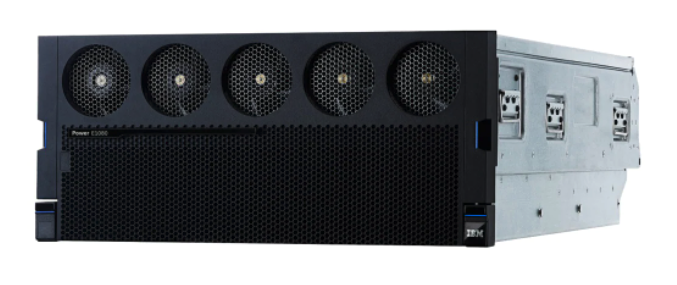The Power E1080 is the newest addition to IBM Power family, the industry’s best-in class server platform for security and reliability. The Power E1080 introduces the essential enterprise hybrid cloud platform, which is uniquely designed to help you securely and efficiently scale core operational and artificial intelligence (AI) applications anywhere in a hybrid cloud.
The Power E1080 simplifies end-to-end encryption and brings AI where your data is stored for faster insights. This configuration helps enable greater workload deployment flexibility and agility while accomplishing more work. The Power E1080 can help you to realize the following benefits:
Protect Trust from Core to Cloud
Protect data that is in-transit and at-rest with greatly simplified end-to-end encryption across hybrid cloud without affecting performance.
Enjoy Enterprise Quality of Service
The Power E1080 can detect, isolate, and recover from soft errors automatically in the hardware without taking an outage or relying on an operating system to manage the faults.
Drive Greater Efficiency with Sustainable and Scalable Compute
The processor performance, massive system throughput, and memory capacity qualify the Power E1080 server to be the perfect workload consolidation platform. This performance entails significant savings in floor space, energy consumption, and operational expenditure costs.
The Power E1080 is the most powerful and scalable server of the IBM Power portfolio, and offers the following relevant functions:
- Designed to support up to four system nodes and up to 240 IBM Power10™ processor cores. The Power E1080 can be ordered as a one, two, three, or four-node configuration with each node providing up to 60 Power10 processor cores to a maximum 240 Power10 processor cores in a four-node configuration.
- Designed to support up to 64 TB memory. The Power E1080 can be initially ordered with the total memory RAM capacity up to 8 TB and supports up to 64 TB in a full combined four system nodes server.
- Designed to support up to 32 Peripheral Component Interconnect® (PCIe) Gen 5 slots in a full combined four system node server and up to 192 PCIe Gen 3 slots with expansion I/O drawers.
- Up to over 4,000 directly attached serial-attached SCSI (SAS) disks or solid-state drives (SSDs).
- Up to 1,000 virtual machines (VMs) with logical partitions (LPARs) per system.
- System control unit, providing redundant system master Flexible Service Processor (FSP).
- Supports IBM Power System Private Cloud Solution with Dynamic Capacity.

System Features
The Power E1080 offers various system features to enable users to build a highly available, scalable, reliable, and flexible system around the application.
Minimum Configuration:
A minimum configuration allows a user to order a fully qualified and tested hardware configuration of a Power system with a minimum set of offered technical features. The modular design of a Power E1080 server enables the user to start low with a minimum configuration and scale up vertically as and when needed.
Processor Features:
Each system node in a Power E1080 server provides four sockets to accommodate Power10 single chip modules (SCMs). Each processor feature code represents four of these sockets, which are offered in 10-core, 12-core, and 15-core density. The system configuration requires one, two, three, or four quantities of the same processor feature, according to the number of system nodes.


Memory Features:
Careful selection of the memory features available on a Power E1080 server helps the user to configure their system with the correct amount of memory that can meet the demands of memory intensive workloads. On a Power E1080 server, the memory features can be classified into the following feature categories:
- Physical Memory
Physical memory features that are supported on Power E1080 are the next generation differential dual inline memory modules, called DDIMM. DDIMMs that are used in the E1080 are Enterprise Class 4U DDIMMs. The memory DDIMM features are available in 32-, 64-, 128-, and 256-GB capacity. Among these DDIMM features, 32 GB and 64 GB DDIMMs run at 3200 MHz frequency and 128 GB, and 256 GB DDIMMs run at 2933 MHz frequency.
Each system node provides 64 DDIMM slots that support a maximum of 16 TB memory and a four-system node E1080 can support a maximum of 64 TB memory. DDIMMs are ordered by using memory feature codes, which include a bundle of four DDIMMs with the same capacity.
- Memory Activation
Software keys are required to activate part or all of the physical memory that is installed in the Power E1080 to be assigned to logical partitions (LPAR). Any software key is available when the memory activation feature is ordered. The memory activation feature can be ordered at any time during the lifecycle of the server to help the user scale up memory capacity without outages, unless a more physical memory upgrade and activation are required.
A server administrator or user cannot control which physical memory DDIMM features are activated when memory activations are used. The amount of memory to activate depends on the feature code ordered; for example, if an order contains two of feature code EDAB (100 GB DDR4 Mobile Memory Activation for HEX), these feature codes activate 200 GB of the installed physical memory.
System Node PCIe Features:
Each system node provides eight PCIe Gen 5 hot-plug enabled slots; therefore, a two-system nodes server provides 16 slots, a three-system nodes server provides 24 slots, and a four-system nodes system provides 32 slots.
System Node Disk and Media Features:
Power E1080 server node supports up to four 7 mm NVMe U.2 drives that are plugged into the 4-bay NVMe carrier backplane (feature code EJBC). Each system node requires one backplane, even if no NVMe U.2 drives are selected. Each NVMe U.2 drive can be independently assigned to different LPARs for hosting the operating system and to start from them. They also can be used for non-data intensive workloads. NVMe U.2 drives are concurrently replaceable.
System Node USB Features:
The Power E1080 supports one stand-alone external USB drive that is associated to feature code EUA5. The feature code includes the cable that is used to the USB drive to the preferred front accessible USB port on the SCU. The Power E1080 server node does not offer an integrated USB port. The USB 3.0 adapter feature code EC6J is required to provide connectivity to an optional external USB DVD drive and requires one system node or I/O expansion drawer PCIe slot. The adapter connects to the USB port in the rear of the SCU with the cable associated to feature code EC6N. Because this cable is 1.5 m long, in case of a Power E1080 with more than one system node, the USB 3.0 adapter can be used in the first or the second system node only.


Power Supply Features:
Each Power E1080 server node has four 1950 W bulk power supply units that are operating at 240 V. These power supply unit features are a default configuration on every Power E1080 system node. The four units per system node do not have an associated feature code and are always auto selected by the IBM configurator when a new configuration task is started. Four power cords from the power distribution units (PDU) drive these power supplies, which connect to four C13/C14 type receptacles on the line cord conduit in the rear of the system. The power line cord conduit source power from the rear and connects to the power supply units in the front of the system. The system design provides N+2 redundancy for system bulk power, which allows the system to continue operation with any two of the power supply units functioning. The failed units must remain in the system until new power supply units are available for replacement. The power supply units are hot-swappable, which allows replacement of a failed unit without system interruption. The power supply units are placed in front of the system, which makes any necessary service that much easier.
System Node PCIe Interconnect Features:
Each system node provides 8 PCIe Gen5 hot-plug enabled slots; therefore, a 2-node system provides 16 slots, a 3-node system provides 24 slots, and a 4-node system provides 32 slots. Up to four I/O expansion drawer features #EMX0 can be connected per node.
When cyber resilience and efficient scaling are absolute musts, you need an enterprise-grade hybrid cloud infrastructure engineered to handle it all. IBM Power® E1080 makes the most secure and reliable server platform in its class even better with transparent memory encryption, efficient scaling, and faster insights with production-ready AI at the point of data.
Read more about IBM POWER 10 in our blog, “IBM POWER10: A State-of-the-Art Processor for Hybrid Cloud Computing.”

